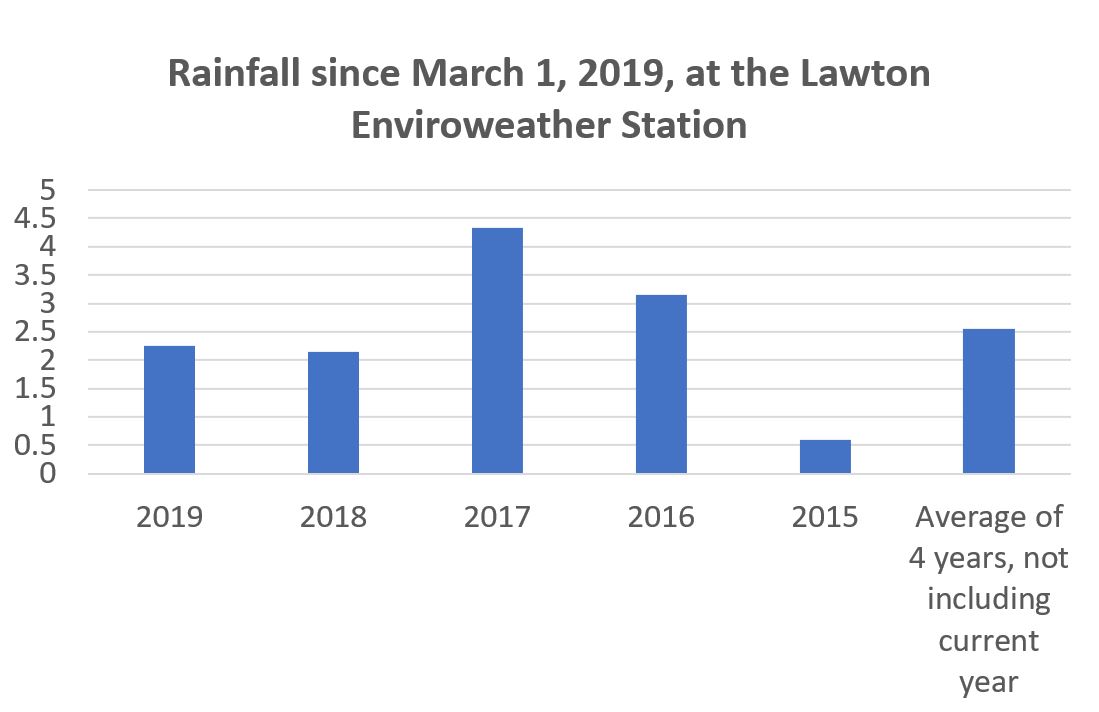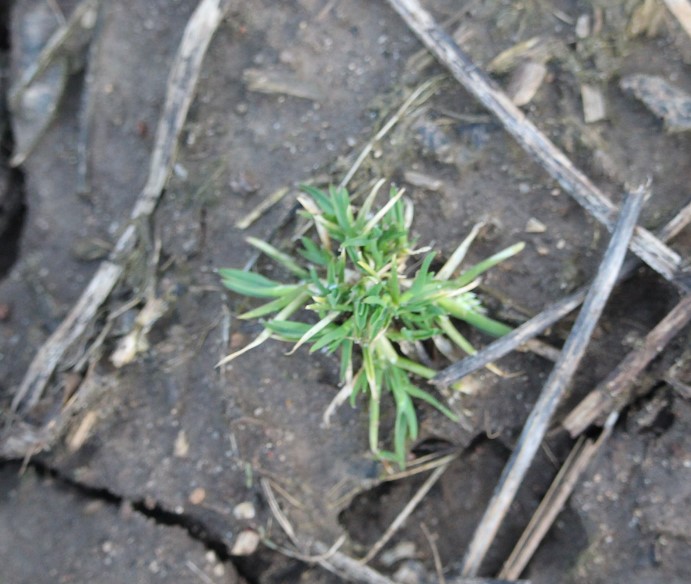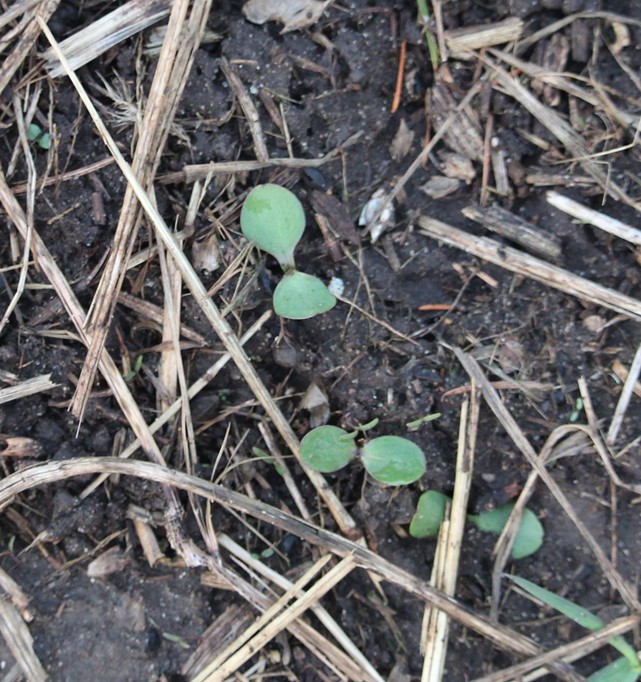Southwest Michigan field crops update – April 10, 2019
The late winter, early spring weather in 2019 has been quite variable.

Weather
The late winter, early spring weather in 2019 has been quite variable. In terms of heat accumulation, which tends to spur on winter annual weeds and wheat growth, the growing degree day (GDD) accumulation values have been colder than average by about 14 GDDs base 50 degrees Fahrenheit. (Note: Base 41 F values are used for alfalfa growth and development.) We had 31 GDDs base 50 F accumulation compared to 6 GDDs in the extremely cold March of 2018. As of April 5, 2019, we have just begun to see cover crops, wheat and winter annual weeds begin to green up.
Total GDDs impact soil temperatures. Cold conditions in early spring often lead to slow warmup of soils. However, a series of warm days and nights, particularly sunny days or a warm rainfall event, can rapidly change soil temperatures for the better, especially on tilled ground.
The Michigan State University Enviroweather stations provide easy access to weather conditions across many areas of Michigan. The stations provide information on rainfall totals, soil temperatures, overnight low temperatures (including hours below freezing), wind speed, temperature inversion potential and pest development models.

March rainfall was much closer to normal. However, soil moisture levels remain high because of ample rainfall during brief warmup events in January and February. The trend for more “out-of-season” rainfall has been noted as part of the changing environment recorded in southwest Michigan over the last 30 years. The trend shows more precipitation falling during the winter and increasingly intense rainfalls during the growing season with less frequency of light rainfall events.
6-10- and 8-14-day NOAA outlooks
The 6-10-day NOAA outlook shows Michigan in the eastern edge of a colder than normal air mass that covers most of the Midwest. However, we are likely to be near normal in precipitation. The 8-14-day outlook shows a moderation in temperatures, but still below normal. This period also is expected to have increased precipitation.
Weed management in the early season warmup period

The situation we want to keep an eye on early in the growing season is winter annual weed growth. Chickweed, henbit and purple deadnettle germinated last fall and remained dormant during the winter months. These plants can turn on growth almost immediately with the first few days of warmth. Rapid growth can make tillage operations less effective by holding the soil together in blocky clumps.
Another species, annual bluegrass, is becoming more prevalent in southwest Michigan fields. These plants germinate in the fall as soil temperatures fall below 70 F. Bluegrass is particularly capable of creating clods with delayed tillage operations. Timely tillage or burndown applications can reduce these challenges.

Winter annual weeds also provide the right kind of environment that can help insects such as Asiatic garden beetle and Japanese beetle larvae (white grubs) and soybean cyst nematodes “green bridge” that thrive by feeding on their roots as the soils first begin to warm. These weed species also create excellent egglaying habitats for “deposited pests” such as black cutworm and armyworm moths to lay eggs. Note the weed or cover crop level in the field at the time the moths arrive to evaluate the likelihood the field will potentially need to be scouted. Purdue University has begun detecting black cutworm moths in traps in the southern half of the state in the first week of April, and with the weather coming out of the south this past weekend, we may begin spotting them early this year in southwest Michigan. Fields that have been burned down or tilled by this time are not likely to need scouting following seedling emergence. MSU weed control specialist Christy Sprague wrote an excellent article highlighting the advantages of early season weed control and control options last spring.
Winter annual weeds also provide challenges in wheat. Wheat plants are particularly sensitive to competition from weeds during their early vegetative growth stages in Michigan, which will begin shortly. Scout wheat fields for weed pressure in mid-April and don’t overlook these species. For more information on weed control options in wheat, visit the MSU Weed Control Guide for Field and Forage Crops.
Early season observations for Asiatic garden beetle white grubs
Extreme wet conditions in southwest Michigan last spring may have tended to reduce the adult populations of Asiatic garden beetles in some areas. Field crops entomologist Chris DiFonzo observed some of these pest’s larvae on the surface of the soil, similar to earthworms in saturated soils. However, there were plenty of survivors in slightly sandier fields, so it is doubtful the population dip will be widespread or long lived.

This pest remains frustrating to growers in the region. The white grubs are underground while the adults are primarily active at night, and it is difficult to spend time scouting before planting. These larvae continue to sporadically ambush corn fields across southern Michigan. Field observations last year revealed that Asiatic garden beetles infest the sandiest fields or the sandiest portions of fields with much more frequency. The goal is to identify fields that have significant levels of white grubs before planting. Watch for grubs being “turned up” to the soil surface during tillage operations. Pay special attention to the lightest soils in fields when scouting. Areas that had higher populations of weeds such as marestail, giant ragweed and wild carrot (as well as possible other species) may have been more attractive to egglaying last summer.
DiFonzo and Ohio State University entomologist Kelly Tilmon worked cooperatively to produce an excellent bulletin on the life cycle and habitat of these pests. Unfortunately, it is not available online yet. Contact the Van Buren County MSU Extension office at 269-657-8213 or msue.vanburen@county.msu.edu and we will send you a PDF copy.
There are no rescue treatments for these pests, so early detection is important in determining if high rates of seed treatment or soil insecticides should be used to control. In soils with high populations, soil insecticides may not be effective. Table IL (page 58) of the 2019 MSU Weed Control Guide for Field and Forage Crops has a list of herbicides that can cause potential interactions if an organophosphate soil insecticide was used at planting time.
Research in southwest Michigan this summer
MSU field crops pathologist Martin Chilvers will conduct research trying to better understand ways to control the new corn disease corn tar spot. He will also be continuing work on soybean sudden death syndrome near Decatur, Michigan. We will be working closely with Chilvers to further investigate the impact irrigation has on tar spot incidence and severity.
Want to stay current with field crop pest and management issues? Check out the Field Crops Virtual Breakfast.
The MSU Extension field crops team will be hosting a Virtual Breakfast every Thursday morning from 7–7:30 a.m. via Zoom starting April 25 through Sept. 5, 2019. Each week, someone from the MSU Extension field crops team will provide a short presentation on a timely topic followed by updates of what we are seeing in the field. MSU agricultural climatologist Jeff Andresen will also share a 7-10-day weather outlook each week.
Participating is easy:
- By computer or mobile device (audio and visual), follow the Zoom link at https://msu.zoom.us/j/552324349.
- By phone (audio only), dial 669-900-6833 and enter meeting ID 552-324-349.
For those who can’t join on Thursdays at 7 a.m., the Virtual Breakfast sessions will be recorded and posted on the Field Crops Virtual Breakfast website and as a podcast.
To receive a weekly reminder of the Virtual Breakfast, sign up at http://eepurl.com/gm-PIv.
Local breaking situations in southwest Michigan
Eric Anderson and I will be providing breaking pest management updates via email and Twitter. If you use Twitter, follow me @BruceMacKellar. You can also sign up for a weekly e-newsletter that will contain timely crop and pest management information for our region by sending a message to msue.vanburen@county.msu.edu with the subject line: “Please add me to the Field Crops List.”
Don’t forget to also subscribe to the MSU Extension Field Crop Production newsletter to receive weekly information on crop updates, news articles and events throughout Michigan.



 Print
Print Email
Email




